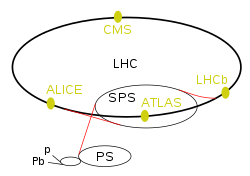
Back لولب مركب للميون Arabic CMS (детектор) Bulgarian কম্প্যাক্ট মিউওন সলিনয়েড Bengali/Bangla Solenoide compacte per a muons Catalan Compact Muon Solenoid German CMS (πείραμα) Greek Compact Muon Solenoid English Experimento CMS Spanish سیملوله فشرده میونی FA CMS (koelaitteisto) Finnish
| Large Hadron Collider (LHC) | |
|---|---|
 La catena degli acceleratori del CERN, organizzati in stadi successivi di accelerazione terminanti con l'iniezione in LHC. | |
| Esperimenti del LHC | |
| ATLAS | A Toroidal LHC Apparatus |
| CMS | Compact Muon Solenoid |
| LHCb | LHC-beauty |
| ALICE | A Large Ion Collider Experiment |
| TOTEM | Total Cross Section, Elastic Scattering and Diffraction Dissociation |
| LHCf | LHC-forward |
| MoEDAL | Monopole and Exotics Detector At the LHC |
| FASER | ForwArd Search ExpeRiment |
| SND | Scattering and Neutrino Detector |
| Preacceleratori del LHC | |
| p e Pb | Acceleratori lineari di protoni (Linac 2) e di piombo (Linac 3) |
| PSB (non mostrato) | Proton Synchrotron Booster |
| PS | Proton Synchrotron |
| SPS | Super Proton Synchrotron |
L'esperimento Compact Muon Solenoid (CMS) è uno dei due grandi rivelatori di particelle di indirizzo generale costruiti sul Large Hadron Collider (LHC) al CERN al confine tra la Svizzera e la Francia. Lo scopo dell'esperimento CMS è compiere ricerche su una vasta gamma di fenomeni fisici, tra cui la ricerca del bosone di Higgs, di dimensioni extra, e delle particelle che potrebbero costituire la materia oscura.
Il CMS è lungo 21 metri, ha un diametro di 15 m, e pesa circa 14000 tonnellate.[1] La collaborazione del CMS, che costruì e ora gestisce il rivelatore, è formata da circa 3800 persone, rappresentanti 199 istituti scientifici e 43 nazioni.[2] Si trova in una caverna sotterranea a Cessy in Francia, poco oltre il confine da Ginevra. A luglio del 2012, insieme ad ATLAS, CMS sembrava che avesse scoperto il bosone di Higgs.[3][4][5] Nel marzo successivo la sua esistenza fu confermata.[6]
- ^ The Compact Muon Solenoid Experiment (PDF), su stfc.ac.uk. URL consultato il 18 ottobre 2014 (archiviato dall'url originale il 18 ottobre 2014).
- ^ CMS Collaboration - CMS Experiment, su cms.web.cern.ch. URL consultato il 20 dicembre 2017.
- ^ C. Biever, It's a boson! But we need to know if it's the Higgs, in New Scientist, 6 luglio 2012. URL consultato il 9 gennaio 2013.«'As a layman, I would say, I think we have it,' said Rolf-Dieter Heuer, director general of CERN at Wednesday's seminar announcing the results of the search for the Higgs boson. But when pressed by journalists afterwards on what exactly 'it' was, things got more complicated. 'We have discovered a boson – now we have to find out what boson it is'
Q: 'If we don't know the new particle is a Higgs, what do we know about it?' We know it is some kind of boson, says Vivek Sharma of CMS [...]
Q: 'are the CERN scientists just being too cautious? What would be enough evidence to call it a Higgs boson?' As there could be many different kinds of Higgs bosons, there's no straight answer.
[emphasis in original]» - ^
T. Siegfried, Higgs Hysteria, in Science News, 20 luglio 2012. URL consultato il 9 dicembre 2012.«In terms usually reserved for athletic achievements, news reports described the finding as a monumental milestone in the history of science.»
- ^
A. Del Rosso, Higgs: The beginning of the exploration, su CERN Bulletin, 47–48, 19 novembre 2012. URL consultato il 9 gennaio 2013.«Even in the most specialized circles, the new particle discovered in July is not yet being called the “Higgs boson". Physicists still hesitate to call it that before they have determined that its properties fit with those the Higgs theory predicts the Higgs boson has.»
- ^ C. O'Luanaigh, New results indicate that new particle is a Higgs boson, su home.web.cern.ch, CERN, 14 marzo 2013. URL consultato il 9 ottobre 2013.